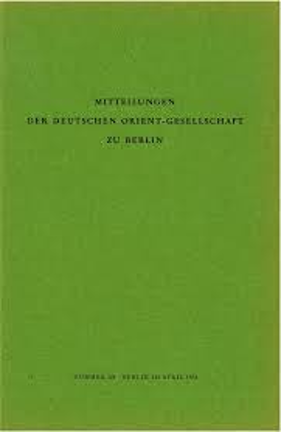Publications so far
0
| 1. | Fuchs, Christian: A Study of the Defensive Architecture on the Site. In: Proceedings of the First International Conference on the Commemoration of Rashid al-Din Fazl-Allah Hamadani (University of Tabriz, March 2021), pp. 265-294, University of Tabriz Press, Tabriz, 2021. (Type: Book Chapter | BibTeX)@inbook{nokey, | |
| 2. |  | Brown, Michael: The Mountain Fortresses of Rabana-Merquly in Iraqi-Kurdistan. In: BAF-Online: Proceedings of the Berner Altorientalisches Forum, vol. 4, no. 1, 2020. (Type: Journal Article | Abstract | Links | BibTeX)@article{nokey,The twin fortresses of Rabana-Merquly are situated on the western side of Mt. Piramagrun, one of the most prominent massifs in the Zagros Mountains. A defining feature of these adjoining settlements are their matching, approximately life-size rock-reliefs depicting a ruler in Parthian dress, which flank the entrance to both sites. Behind the perimeter walls several structures have been recorded including a citadel and a sanctuary complex. The combined intramural area is in excess of 40 hectares. Based on the style of relief sculptures, and the material culture of their associated intramural settlements, occupation is dated to the early first millennium A.D. Investigations at Rabana-Merquly are a collaboration between Heidelberg University and the Sulaymaniyah Directorate of Antiquities. This talk gives an overview of the main fieldwork results to date, emphasizing the relationship between the fortified settlements and the wider landscape of the central Zagros highlands. |
| 3. |  | Brown, Michael; Rasheed, Kamal; Dörr, Roxana; Heiler, Jan: Die Bergbefestigung von Rabana-Merquly in Irakisch-Kurdistan: Ein Vorbericht der Grabungskampagne 2019. In: Mitteilungen der Deutschen Orient-Gesellschaft, iss. 152, pp. 91-110, 2020. (Type: Journal Article | Abstract | Links | BibTeX)@article{nokey,On the slopes of Mt. Piramagrun in the Zagros Mountains of Iraqi Kurdistan lies the fortified site of Rabana-Merquly. Ruins spread across c. 100 ha represent a major occupation during the Parthian period. Matching rock-reliefs that depict an anonymous ruler flank the two main entrances to the settlements. Pronounced similarities in attire between these sculptures and the statue of a king of Adiabene found at Hatra suggest a possible identification for both the individual depicted in relief (Natounissar) and the ancient city (Natounia-on-the-Kapros). Fieldwork in 2019 continued our ongoing programme of survey and excavation, with more detailed investigation of the complex at the entrance to Rabana valley. |
| 4. | Kleiss, Wolfram: Europäische Befestigungsarchitektur in Iran vom 16. bis zum 19. Jahrhundert. In: Archäologische Mitteilungen aus Iran, vol. 13, pp. 167-178, 1980. (Type: Journal Article | BibTeX)@article{nokey, | |
| 5. |  | Hallier, Ulrich W.: Qual'eh Zari, ein prä-islamisches Fort in Ostpersien. In: Archäologische Mitteilungen aus Iran, vol. N.F.6, pp. 189-196, 1973. (Type: Journal Article | BibTeX)@article{nokey, |
| 6. | Hallier, Ulrich W.: Qual'eh Tari, ein prä-islamisches Fort in Ostpersien. In: Archäologische Mitteilungen aus Iran, vol. 6, pp. 189-196, 1973. (Type: Journal Article | BibTeX)@article{nokey, |
2021 |
|
Fuchs, Christian: A Study of the Defensive Architecture on the Site. In: Proceedings of the First International Conference on the Commemoration of Rashid al-Din Fazl-Allah Hamadani (University of Tabriz, March 2021), pp. 265-294, University of Tabriz Press, Tabriz, 2021. (Type: Book Chapter | BibTeX | Tags: Fortification)@inbook{nokey, | |
2020 |
|
 | Brown, Michael: The Mountain Fortresses of Rabana-Merquly in Iraqi-Kurdistan. In: BAF-Online: Proceedings of the Berner Altorientalisches Forum, vol. 4, no. 1, 2020. (Type: Journal Article | Abstract | Links | BibTeX | Tags: Fortification, Kurdistan, Landscape, Parthian, Persian empire, Resilience)@article{nokey,The twin fortresses of Rabana-Merquly are situated on the western side of Mt. Piramagrun, one of the most prominent massifs in the Zagros Mountains. A defining feature of these adjoining settlements are their matching, approximately life-size rock-reliefs depicting a ruler in Parthian dress, which flank the entrance to both sites. Behind the perimeter walls several structures have been recorded including a citadel and a sanctuary complex. The combined intramural area is in excess of 40 hectares. Based on the style of relief sculptures, and the material culture of their associated intramural settlements, occupation is dated to the early first millennium A.D. Investigations at Rabana-Merquly are a collaboration between Heidelberg University and the Sulaymaniyah Directorate of Antiquities. This talk gives an overview of the main fieldwork results to date, emphasizing the relationship between the fortified settlements and the wider landscape of the central Zagros highlands. |
 | Brown, Michael; Rasheed, Kamal; Dörr, Roxana; Heiler, Jan: Die Bergbefestigung von Rabana-Merquly in Irakisch-Kurdistan: Ein Vorbericht der Grabungskampagne 2019. In: Mitteilungen der Deutschen Orient-Gesellschaft, iss. 152, pp. 91-110, 2020. (Type: Journal Article | Abstract | Links | BibTeX | Tags: Fortification, Kurdistan, Landscape, Parthian, Resilience)@article{nokey,On the slopes of Mt. Piramagrun in the Zagros Mountains of Iraqi Kurdistan lies the fortified site of Rabana-Merquly. Ruins spread across c. 100 ha represent a major occupation during the Parthian period. Matching rock-reliefs that depict an anonymous ruler flank the two main entrances to the settlements. Pronounced similarities in attire between these sculptures and the statue of a king of Adiabene found at Hatra suggest a possible identification for both the individual depicted in relief (Natounissar) and the ancient city (Natounia-on-the-Kapros). Fieldwork in 2019 continued our ongoing programme of survey and excavation, with more detailed investigation of the complex at the entrance to Rabana valley. |
1980 |
|
Kleiss, Wolfram: Europäische Befestigungsarchitektur in Iran vom 16. bis zum 19. Jahrhundert. In: Archäologische Mitteilungen aus Iran, vol. 13, pp. 167-178, 1980. (Type: Journal Article | BibTeX | Tags: Architecture, Fortification)@article{nokey, | |
1973 |
|
 | Hallier, Ulrich W.: Qual'eh Zari, ein prä-islamisches Fort in Ostpersien. In: Archäologische Mitteilungen aus Iran, vol. N.F.6, pp. 189-196, 1973. (Type: Journal Article | BibTeX | Tags: Fortification, South Khorasan)@article{nokey, |
Hallier, Ulrich W.: Qual'eh Tari, ein prä-islamisches Fort in Ostpersien. In: Archäologische Mitteilungen aus Iran, vol. 6, pp. 189-196, 1973. (Type: Journal Article | BibTeX | Tags: Fortification)@article{nokey, | |
